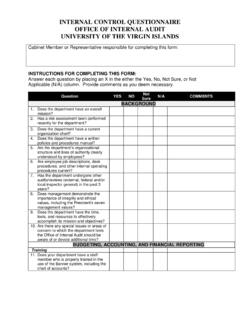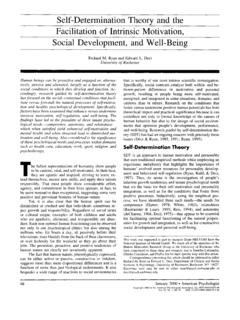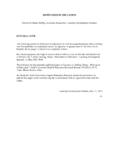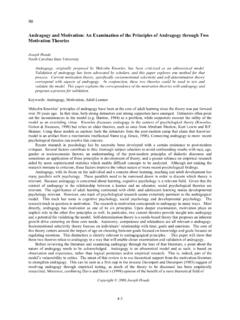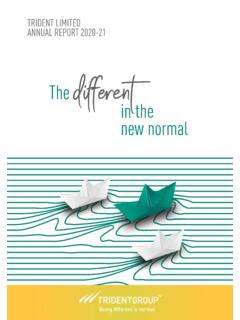Transcription of Self-Determination Theory and the Facilitation of ...
1 Self-Determination Theory and the Facilitation of intrinsic motivation , social development , and well -Being Richard M. Ryan and Edward L. Deci University of Rochester Human beings can be proactive and engaged or, alterna- tively, passive and alienated, largely as a function of the social conditions in which they develop and function. Ac- cordingly, research guided by Self-Determination theo~ has focused on the social -contextual conditions that facil- itate versus forestall the natural processes of self-motiva- tion and healthy psychological development . Specifically, factors have been examined that enhance versus undermine intrinsic motivation , self-regulation, and well -being. The findings have led to the postulate of three innate psycho- logical needs--competence, autonomy, and relatedness-- which when satisfied yield enhanced self- motivation and mental health and when thwarted lead to diminished mo- tivation and well -being.
2 Also considered is the significance of these psychological needs and processes within domains such as health care, education, work, sport, religion, and psychotherapy. T he fullest representations of humanity show people to be curious, vital, and self-motivated. At their best, they are agentic and inspired, striving to learn; ex- tend themselves; master new skills; and apply their talents responsibly. That most people show considerable effort, agency, and commitment in their lives appears, in fact, to be more normative than exceptional, suggesting some very positive and persistent features of human nature. Yet, it is also clear that the human spirit can be diminished or crushed and that individuals sometimes re- ject growth and responsibility. Regardless of social strata or cultural origin, examples of both children and adults who are apathetic, alienated, and irresponsible are abun- dant. Such non-optimal human functioning can be observed not only in our psychological clinics but also among the millions who, for hours a day, sit passively before their televisions, stare blankly from the back of their classrooms, or wait listlessly for the weekend as they go about their jobs.
3 The persistent, proactive, and positive tendencies of human nature are clearly not invariantly apparent. The fact that human nature, phenotypically expressed, can be either active or passive, constructive or indolent, suggests more than mere dispositional differences and is a function of more than just biological endowments. It also bespeaks a wide range of reactions to social environments that is worthy of our most intense scientific investigation. Specifically, social contexts catalyze both within- and be- tween-person differences in motivation and personal growth, resulting in people being more self-motivated, energized, and integrated in some situations, domains, and cultures than in others. Research on the conditions that foster versus undermine positive human potentials has both theoretical import and practical significance because it can contribute not only to formal knowledge of the causes of human behavior but also to the design of social environ- ments that optimize people's development , performance, and well -being.
4 Research guided by Self-Determination the- ory (SDT) has had an ongoing concern with precisely these issues (Deci & Ryan, 1985, 1991; Ryan, 1995). Self-Determination Theory SDT is an approach to human motivation and personality that uses traditional empirical methods while employing an organismic metatheory that highlights the importance of humans' evolved inner resources for personality develop- ment and behavioral self-regulation (Ryan, Kuhl, & Deci, 1997). Thus, its arena is the investigation of people's inherent growth tendencies and innate psychological needs that are the basis for their self- motivation and personality integration, as well as for the conditions that foster those positive processes. Inductively, using the empirical pro- cess, we have identified three such needs--the needs for competence (Harter, 1978; White, 1963), relatedness (Baumeister & Leary, 1995; Reis, 1994), and autonomy (deCharms, 1968; Deci, 1975)--that appear to be essential for facilitating optimal functioning of the natural propen- sities for growth and integration, as well as for constructive social development and personal well -being.
5 This work was supported in part by research Grant MH-53385 from the National Institute of Mental Health. We thank all of the members of the Human motivation Research Group at the University of Rochester who have contributed to these ideas and research, and to Jennifer LaGuardia, Charles Couchman, and Phyllis Joe for their specific help with this article. Correspondence concerning this article should be addressed to either Richard M. Ryan or Edward L. Deci, Department of Clinical and social Sciences in Psychology, University of Rochester, Rochester, NY 14627. Electronic mail may be sent to either or 68 January 2000 American Psychologist Copyright 2000 by the American Psychological Association, Inc. 0003-066X/00/$ Vol. 55, No. 1, 68-78 DOI: Richard M. Ryan Photo by Joe Gawlowicz, University of Rochester Much of the research guided by SDT has also exam- ined environmental factors that hinder or undermine self- motivation , social functioning, and personal well -being.
6 Although many specific deleterious effects have been ex- plored, the research suggests that these detriments can be most parsimoniously described in terms of thwarting the three basic psychological needs. Thus, SDT is concerned not only with the specific nature of positive developmental tendencies, but it also examines social environments that are antagonistic toward these tendencies. The empirical methods used in much of the SDT research have been in the Baconian tradition, in that social contextual variables have been directly manipulated to examine their effects on both internal processes and behav- ioral manifestations. The use of experimental paradigms has allowed us to specify the conditions under which peo- ple's natural activity and constructiveness will flourish, as well as those that promote a lack of self- motivation and social integration. In this way, we have used experimental methods without accepting the mechanistic or efficient causal meta-theories that have typically been associated with those methods.
7 In this article we review work guided by SDT, ad- dressing its implications for three important outcomes. We begin with an examination of intrinsic motivation , the prototypic manifestation of the human tendency toward learning and creativity, and we consider research specify- ing conditions that facilitate versus forestall this special type of motivation . Second, we present an analysis of self-regulation, which concerns how people take in social values and extrinsic contingencies and progressively trans- form them into personal values and self-motivations. In that discussion, we outline different forms of internalized motivation , addressing their behavioral and experiential correlates and the conditions that ale likely to promote these different motivations. Third, we focus on studies that have directly examined the impact of psychological need fulfillment on health and well -being. The Nature of motivation motivation concerns energy, direction, persistence and equifinality--all aspects of activation and intention.
8 Moti- vation has been a central and perennial issue in the field of psychology, for it is at the core of biological, cognitive, and social regulation. Perhaps more important, in the real world, motivation is highly valued because of its conse- quences: motivation produces. It is therefore of preeminent concern to those in roles such as manager, teacher, reli- gious leader, coach, health care provider, and parent that involve mobilizing others to act. Although motivation is often treated as a singular construct, even superficial reflection suggests that people are moved to act by very different types of factors, with highly varied experiences and consequences. People can be motivated because they value an activity or because there is strong external coercion. They can be urged into action by an abiding interest or by a bribe. They can behave from a sense of personal commitment to excel or from fear of being surveilled.
9 These contrasts between cases of having internal motivation versus being externally pressured are surely familiar to everyone. The issue of whether people stand behind a behavior out of their interests and values, or do it for reasons external to the self, is a matter of signif- icance in every culture ( , Johnson, 1993) and represents a basic dimension by which people make sense of their own and others' behavior (deCharms, 1968; Heider, 1958; Ryan & Connell, 1989). Comparisons between people whose motivation is au- thentic (literally, self-authored or endorsed) and those who are merely externally controlled for an action typically reveal that the former, relative to the latter, have more interest, excitement, and confidence, which in turn is man- ifest both as enhanced performance, persistence, and cre- ativity (Deci & Ryan, 1991; Sheldon, Ryan, Rawsthorne, & Ilardi, 1997) and as heightened vitality (Nix, Ryan, Manly, & Deci, 1999), self-esteem (Deci & Ryan, 1995), and general well -being (Ryan, Deci, & Grolnick, 1995).
10 This is so even when the people have the same level of perceived competence or self-efficacy for the activity. Because of the functional and experiential differences between self- motivation and external regulation, a major focus of SDT has been to supply a more differentiated approach to motivation , by asking what kind of motivation is being exhibited at any given time. By considering the perceived forces that move a person to act, SDT has been able to identify several distinct types of motivation , each of which has specifiable consequences for learning, perfor- mance, personal experience, and well -being. Also, by ar- ticulating a set of principles concerning how each type of motivation is developed and sustained, or forestalled and undermined, SDT at once recognizes a positive thrust to human nature and provides an account of passivity, alien- ation, and psychopathology. January 2000 American Psychologist 69 Edward L.


